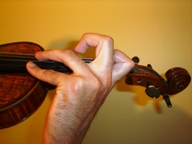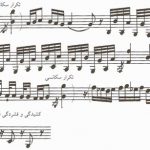
4.3.1.3 Regarding the great linear distance and the unusual distance between the first and forth fingers, the first finger while playing the doubles of ninth and tenth interval, can be twisted in the knuckle area and the point mentioned in 3.1.2.5 paragraph in relation to the way first finger is placed indicating that the first joint of this finger in back of hand must be in line with the direction of forearm and left hand is not true here.
4.1.3 Placing finger in the non-neighboring strings
As the previous paragraph, placing fingers in the non-neighboring strings must be performed without any unnecessary movement of hand.
Player’s wrist while changing from bass string to non-neighboring tenor string, should not be twisted to right. Also it is not necessary to move out forearm from the fingerboard toward right.
1.4.1.3 when we need left hand in a specific position so that a finger immediately after playing a string is placed on a neighboring or non-neighboring string, and on the other hand, the linear distance of finger from the nut is not changed, it is necessary to be very careful about the exact place of finger (such as playing Do natural in the first position of G string immediately after La natural in the same position of E string with the third finger in the Do major scale).
Considering the last three principles mentioned above, that is twisting hand toward fingerboard (1.1.2 paragraph), avoiding unnecessary movements of left hand for placing finger on the fingerboard and the necessity of placing finger on the fingerboard from the left half of the fingertip (3.1.2.3 paragraph), each finger while opening (placing finger from tenor string to bass string), or closing (placing finger from bass string to tenor string) goes through an oblique path in relation to the direction of fingerboard. However, to use a finger on neighboring strings is much easier than to place finger on an immediately non-neighboring string; because in the first case, finger spends a shorter oblique path on the fingerboard.
If player places finger from tenor string to bass string, it is necessary to bend finger before placing it on the fingerboard and in the opposite state before placing finger on the tenor string, it should be opened .
Although the amount of opening and closing a finger consciously by the player is not so much, giving much attention to this point results in producing an exact note.
2.4.1.3.another point helping greatly to place fingers at non-neighboring strings is to consider the distance between player’s left hand and the base of the instrument’s neck (see notification 11). If this point is not considered by the player and he holds her hand away from the balanced distance between left hand and the fingerboard, then the process of finger placing at neighboring strings would be troubled and the fingertips would not touch the fingerboard (see paragraph 3.1.2.2).
There is a false assumption among some players that the more they keep their left hand away from the fingerboard, the more would be their dominance over the process of finger placing when they desire to change string. However, quite vice versa, it would lead to less dominance on finger placing.

Doubles playing (tenth interval)









